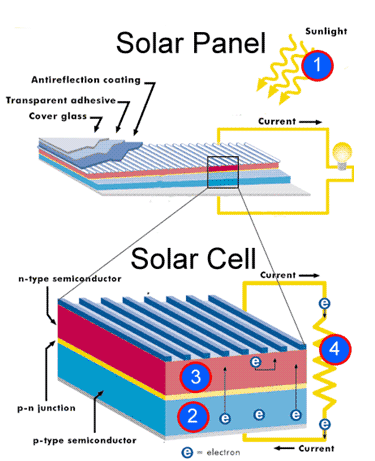This week Josh
showed me a competition for robotics. The competition requires that I design a
robot that presents at least one principle of sustainability. Josh came up with
the idea of building a robot that is equipped with a solar panel. The robot
will follow the sun light to optimize the efficiency of the solar panel. I
decided to go along with his idea because I could not come up with anything of
my own. For this week’s assignment, I decided to look up how basic solar cells
work. I found an interactive activity and article on PBS. This is what I learned:
Solar panels
capture sunlight using photovoltaic cells. These cells are made of two layers
of silicon. Silicon is a poor conductor. To take care of this, one layer has
boron added to it and the other layer has phosphorus added to it. The boron
layer, with fewer electrons, is placed on the bottom and vice versa for the
phosphorus layer. The extra electrons in the phosphorus layer will sink down to
the boron layer. This creates an electric field where the two layers meet. As
sunlight hits the cell, the photons from the sun knock electrons in the silicon
layers loose. The cell is coated with an anti-reflective coat so that the
photons are absorbed instead of reflected away. When the electrons that are
knocked loose reach the electric field, they are pushed upward to the top of
the cell. On the top of the cell lie metal conductor strips. The electrons flow
through these strips towards a wire and then to an inverter. The inverter
converts the direct current into an alternating current for appliances and
other electronic devices to use. Electricity flows back into the cell through a
metal backing and the whole process starts again.
Unfortunately, many
of the electrons that are knocked loose hardly ever make it to the electric
field. This makes the solar cell inefficient. This along with the lack of power
at night and high cost of production make solar panels unpopular. So, for my
next article, I decided to look up ways to make the cell more efficient. I
found a good number of methods. You could make the cell less reflective, use
different materials, and change the structure of the cell so that electrons
found their way to the electric field more easily. I found an article on CPV
panels.
In all honesty I
found methods besides CPV that were much more interesting. I, however, couldn’t
find enough information to write enough and share with you all. Concentrated
photovoltaics (CPV) panels use lenses and mirrors to intensify the light before
it hits the cells. Because of this, the efficiency of a cell increases greatly.
Because of the cells efficiency, fewer are needed in a panel. This brings the
cost of production down. With this, two of the cons of solar panels are at
least identified and made less of a problem.
I have not decided how to design my
robot yet. I was introduced to Auto CAD, a design and modeling software that I
found to be similar to Photoshop. I’m decently skilled in Photoshop so I should
be moving along pretty soon. Below are my citations and links to read the
articles if you are interested.
Chaddha, Rima and Stephanie Chasteen. “Howdo Solar Panel’s Work?” NOVA. PBS, 24 Apr. 2007. Web. 30 Nov. 2012.
Halper, Mark. “Magnifying SolarElectricity’s Future.” SmartPlanet. CBS, 20 May 2011. Web. 30 Nov. 2012.

Interesting reading about why solar panels aren't so popular. I've often wondered why we don't see them everywhere.
ReplyDelete